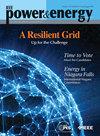让电动汽车和电网协同工作:可持续移动的必要条件[编辑之声]
IF 2.2
3区 工程技术
Q2 ENGINEERING, ELECTRICAL & ELECTRONIC
引用次数: 0
摘要
住宅能源格局正在经历快速转型。2022年,创纪录的70万美国家庭安装了太阳能,而在美国购买的汽车中,近十分之一是电动汽车(EV)(图1)。在加州,最近的立法改革鼓励安装家庭电池存储系统来转移负荷,而参议院法案SB 233要求所有电动汽车都能够双向充电。该法案还旨在扭转一个令人不安的趋势:近年来,加州人越来越多地通过购买柴油驱动的备用发电机来应对停电和轮流停电。相比之下,一些电动汽车电池现在能够为一个家庭提供长达三天的电力,因此被认为是柴油发电机的“绿色”替代品。联邦能源管理委员会第2222号命令也提高了分布式能源(DERs)的竞争力,使它们能够通过聚合参与区域批发市场。事实上,将电动汽车双向充电和太阳能转换与家用电池存储完全集成的商用设备可以作为DERs加以利用。这可以显著提高电网的可靠性,同时推迟昂贵的基础设施升级,并通过在停电期间为家庭供电来增强分散的弹性。本文章由计算机程序翻译,如有差异,请以英文原文为准。
Making electric vehicles and the grid work together: A necessity for sustainable mobility [Editors’ Voice]
The residential energy landscape is undergoing rapid transformation. In 2022, a record 700,000 U.S. homeowners installed solar, while nearly one in 10 cars purchased in the United States was an electrical vehicle (EV) ( Figure 1 ). In California, recent legislative reform incentivized the installation of home battery storage systems for load shifting, while Senate bill SB 233 requires that all EVs are capable of bidirectional charging. The bill was also designed to reverse a troubling trend: In recent years, Californians have increasingly responded to power outages and rolling blackouts by purchasing diesel-propelled backup generators. In contrast, some EV batteries now have the ability to power a home for up to three days and so are considered a “green” alternative to diesel generators. Federal Energy Regulatory Commission Order No. 2222 has also increased the competitiveness of distributed energy resources (DERs) by enabling them to participate in regional wholesale markets through aggregations. Indeed, commercial equipment combining bidirectional EV charging and solar energy conversion that fully integrates with home battery storage can be leveraged as DERs. This can significantly improve grid reliability, while deferring costly infrastructure upgrades and enhancing decentralized resiliency by powering homes during blackouts.
求助全文
通过发布文献求助,成功后即可免费获取论文全文。
去求助
来源期刊

IEEE Power & Energy Magazine
工程技术-工程:电子与电气
CiteScore
5.10
自引率
0.00%
发文量
145
审稿时长
>12 weeks
期刊介绍:
IEEE Power & Energy Magazine is dedicated to disseminating information on all matters of interest to electric power engineers and other professionals involved in the electric power industry with a focus on advanced concepts, technologies, and practices associated with all aspects of electric power from a technical perspective in synergy with nontechnical areas such as business, environmental, and social concerns. IEEE Power & Energy Magazine keeps its readers up-to-date on the latest technological advancements, industry news, business trends and strategies, products, and publications. Important newsworthy items concerning the worldwide activities and achievements of IEEE Power & Energy Society (PES), its organizational units, and its individual members are also included.
 求助内容:
求助内容: 应助结果提醒方式:
应助结果提醒方式:


